No matter how hard you try, you simply can't prepare yourself for your first visit to a German fair. However high your expectations, I defy anyone not to spend their entire visit uttering the words "How can that thing travel?" every thirty seconds or so. Even when you should be used to it, there are some rides that retain this sense of mystique and wonder, and none more so than Eurostar. This epic tangle of dark purple track would be a jaw-dropping sight at any theme park, but the very idea that the whole thing is temporary simply catapults the ride over the edge of believability. As if that weren't enough, it also just happens to be one of the most frantic, intense, and exhilarating coasters you could ever wish to ride.
Debuting in 1995, just eighteen months after Alton Towers' Nemesis became Europe's first inverted coaster, Eurostar is a testament to the fierce rivalry that exists between German showmen. Indeed, the idea that anyone ever seriously thought about making a travelling inverter of this size is amazing, but to then make it a reality is quite simply mind-blowing.
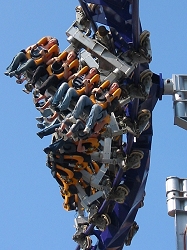 Until Eurostar came along, Germany's tradition of large travelling coasters had stalled slightly. Anton Schwarzkopf, the mastermind behind the likes of Thriller and Dreier Looping, had fallen ill. His last major travelling coaster was 1989's Olympia Looping, while the only other major coaster to appear in this respite had been 1992's enclosed family ride, "Magic Mountain" (now "Star World"). Oscar Bruch, Germany's most famous showman, had been touring his two large coasters, Thriller and Alpina Bahn, for over ten years, and wanted to add something new to his line-up.
Until Eurostar came along, Germany's tradition of large travelling coasters had stalled slightly. Anton Schwarzkopf, the mastermind behind the likes of Thriller and Dreier Looping, had fallen ill. His last major travelling coaster was 1989's Olympia Looping, while the only other major coaster to appear in this respite had been 1992's enclosed family ride, "Magic Mountain" (now "Star World"). Oscar Bruch, Germany's most famous showman, had been touring his two large coasters, Thriller and Alpina Bahn, for over ten years, and wanted to add something new to his line-up.
Meanwhile, B&M was setting the theme park world alight with their new inverted coasters, and so this seemed the obvious direction for Bruch to take. The trouble was that few people were willing or able to take on the massive task of a full-size travelling inverter. As a result, the project came to involve people and companies from all over the continent, an arrangement that provided the inspiration for the ride's eventual name.
Officially, the ride comes from Intamin, although much of the work was sub-contracted to Giovanola, a company that had worked with B&M and would later go on to build coasters under their own name. As for the design, this came from the then-relatively unknown Werner Stengel, who had worked extensively with Anton Schwarzkopf on previous travelling coasters. In addition, the Bruch family were also heavily involved with the design, both in terms of how they wanted it to ride, and how the massive structure could be made easier to transport.
It's worth pausing to think exactly what considerations needed to be made in designing this ride, as they go far beyond anything a theme park ride would need to worry about, and make it easier for us to appreciate what a huge accomplishment Eurostar is.
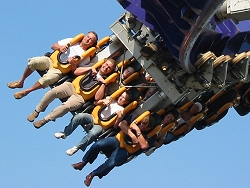 Firstly, the ride needed to be comparable to previous travelling coasters both in terms of ground space, and the time required to build and dismantle. As such, the ride used a similar "plug and socket" structure to the Schwarzkopf coasters. This allowed the ride to be pieced together with minimal fuss, allowing it to be booked onto as many fairs as possible each year, while minimising the need to hire local people to help build and dismantle the ride at each location.
Firstly, the ride needed to be comparable to previous travelling coasters both in terms of ground space, and the time required to build and dismantle. As such, the ride used a similar "plug and socket" structure to the Schwarzkopf coasters. This allowed the ride to be pieced together with minimal fuss, allowing it to be booked onto as many fairs as possible each year, while minimising the need to hire local people to help build and dismantle the ride at each location.
Secondly, while the structure needed to be strong enough to cope with the enormous stresses involved, it needed to be slender enough to pack onto as few lorries as possible in order to reduce the transportation costs. It's no use having a world-class coaster if you have to charge people more to ride it than they're willing to pay.
Thirdly, anyone who has visited a busy German fair will know that the crowds can be colossal. Indeed, the top German fairs attract more people in their 1-2 two week run than most major theme parks get all year. As such, a major coaster needs to have an astronomically high capacity, as you obviously want to get as many people through the gate as the fair's opening hours allow. As such, Eurostar needed to match the ferocious capacity of Schwarzkopf's legendary crowd-crunchers, and is capable of running four 28-seat trains at peak times, forcing staff to maintain loading times far faster than most theme park coasters.
Fourthly, the ride simply needed to look good. Remember, the ride operates in a pay-per-ride environment, and needs all its elements to be clearly visible in order 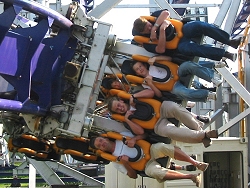 to entice spectators to the paybox. Again, you could have the greatest coaster on the planet, but if it doesn't grab the interest of passers-by and make them want to open their wallets for tickets, it will fail. Schwarzkopf's travelling coasters were a masterclass of "staging", with the lift hill and bigger drops at the back of the ride, and other major elements, such as inversions, perched in the foreground, and often right above the paybox for maximum visual impact.
to entice spectators to the paybox. Again, you could have the greatest coaster on the planet, but if it doesn't grab the interest of passers-by and make them want to open their wallets for tickets, it will fail. Schwarzkopf's travelling coasters were a masterclass of "staging", with the lift hill and bigger drops at the back of the ride, and other major elements, such as inversions, perched in the foreground, and often right above the paybox for maximum visual impact.
Finally, and most obviously, it has to be a good ride. It doesn't take a genius to work out that you can at least double your revenue by offering a coaster that people will want to re-ride. If you get off the ride without having enjoyed it, that's one more ticket that will go unsold.
So there you have it. Versprung durch Technik. Would you fancy trying to design a coaster within these limitations? No, and neither did a lot of other people. It was immensely brave of Werner Stengel to accept the challenge, especially as he was not the legendary figure he is today. Indeed, Eurostar was arguably the first time that Stengel would be regarded as the "star" designer, rather than remaining an anonymous back-room boffin.
Despite opening late at its first few fairs, Bruch's battalion of staff soon managed to find ways of building the ride in less and less time, and using less and less trucks. Nowadays, the whole process goes with military precision, and the ride is always ready for business when the fair opens.
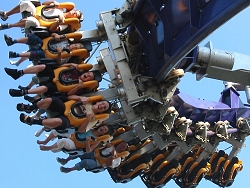 So, we find ourselves standing before the mountain of steel that is Eurostar. Certainly, the need to look good has been met. The ride is staged beautifully, with the twisted first drop in the background, the huge loop dominating the mid-ground, and a lightning fast in-line twist being performed above the paybox and queue. Keep watching, and you'll see the train plough through the twin corkscrews that form one of the ride's many high-speed, high-drama, high-G highlights. At night, the subtle floodlighting reflects beautifully on the structure, giving the ride a gloriously intimidating aura as the trains blur past in all directions.
So, we find ourselves standing before the mountain of steel that is Eurostar. Certainly, the need to look good has been met. The ride is staged beautifully, with the twisted first drop in the background, the huge loop dominating the mid-ground, and a lightning fast in-line twist being performed above the paybox and queue. Keep watching, and you'll see the train plough through the twin corkscrews that form one of the ride's many high-speed, high-drama, high-G highlights. At night, the subtle floodlighting reflects beautifully on the structure, giving the ride a gloriously intimidating aura as the trains blur past in all directions.
At the paybox, a ticket is received for less money than you might reasonably expect, and it is time to join the fast-moving queue. As with many German fair rides, "queue" is not really the appropriate word, as it tends to move at close to walking pace, and so what might look like an hour's queue dissolves in minutes.
As you approach the station, prepare to be in awe of the staff. Usually, when we praise ride staff, it is for their friendliness, but here it is for the ferocious efficiency with which they operate the ride. Forget about politeness, if your group can fill those last few seats, prepare to be virtually grabbed by the neck and thrown into the train. For theme park devotees, this will be yet another indication of the fact that the German fairs are a whole new world, with an unprecedented sense of haste and urgency.
The trains themselves resemble stripped-down B&M cars, with none of the niceties that we associate with Walter and Claude's luxury vehicles. No seatbelts, no moving floors, just the bare minimum needed to hold you in your seat, and to keep the trains running like clockwork. Indeed, when you've ridden Eurostar, the B&M inverters suddenly seem needlessly complex.
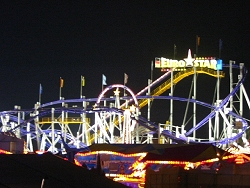 At the sound of a hooter, the train charges away to the rear of the ride, where it engages the deafening lift hill. From here, we are thrown straight into an inverted equivalent of the famous Schwarzkopf twisting first drop, and into the vertical loop with all the speed and fury of a rampaging rhinoceros. Front seat riders will get the first of many scares, as pieces of structure fly past at a proximity that makes them half-expect the ride to trim their toenails for them.
At the sound of a hooter, the train charges away to the rear of the ride, where it engages the deafening lift hill. From here, we are thrown straight into an inverted equivalent of the famous Schwarzkopf twisting first drop, and into the vertical loop with all the speed and fury of a rampaging rhinoceros. Front seat riders will get the first of many scares, as pieces of structure fly past at a proximity that makes them half-expect the ride to trim their toenails for them.
No time to recover, as the train barges into an overbanked turn, ripping wildly to the left as it prepares to soar across the station roof and into the ferocious in-line twist. As with much of the ride, it may lack the grace of the B&M inverters, but what it lacks in finesse, it more than makes up for in sheer aggression. No coaster, Nemesis included, makes you feel so puny in the face of a rampaging typhoon of a ride.
Tearing out of the inline twist, it's time to hit the first set of brakes. Now, it's conventional to bemoan the braking of coasters, but Eurostar is slightly different. While the brakes need to be there to allow the operation of so many trains, the fact that the train slows to a crawl actually serves as a well-earned breather, before hurtling back into the unadulterated mania of the ride. Indeed, if the train were allowed to charge on at full speed, it's doubtful that the riders would live to tell the tale.
The next section simply oozes quality. After a swift drop, the train curls straight into two consecutive corkscrews, both tighter than you would ever think possible at this speed. With its passengers thoroughly disorientated, the train finds itself needing to perform a turn that may well rank as the most intense piece of coaster track on Earth. If you are still conscious enough to know what is going on, this near-hairpin turn pulls enough G-force to send blood rushing straight to your feet, a sensation quite unlike anything other coasters can offer.
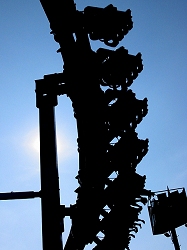 Into another brake run, and the train again slows to a crawl. With all the inversions over, is this the point where the ride calms down? Not a bit of it, for Eurostar has one last trick up its sleeve. Twisting to the right, the track drops into a helix. The speeds get higher and higher, and the turn gets tighter and tighter, and soon riders are feeling the kind of G-force make them fear that the fillings are going to be ripped from their teeth. After what seems like an eternity, the train is effortlessly spat into the final brakes, which accurately simulate the feeling of being smashed into a badly placed brick wall.
Into another brake run, and the train again slows to a crawl. With all the inversions over, is this the point where the ride calms down? Not a bit of it, for Eurostar has one last trick up its sleeve. Twisting to the right, the track drops into a helix. The speeds get higher and higher, and the turn gets tighter and tighter, and soon riders are feeling the kind of G-force make them fear that the fillings are going to be ripped from their teeth. After what seems like an eternity, the train is effortlessly spat into the final brakes, which accurately simulate the feeling of being smashed into a badly placed brick wall.
The organised chaos of the station throws you onto the exit platform, and down an exit path that continues the intimidation by sending trains roaring past at furious speeds. This primeval language of roars and screams can only translate to a challenge to re-ride.
Eurostar is devastatingly awesome. No ride can match it for maniacally grabbing riders by the throat and taking them to the limits of endurance. If you are looking for a passive, calming experience, look elsewhere; Eurostar caters for those of us who like a coaster to show no mercy, to seize us and challenge us to battle it out, to prove our mettle. Once you have ridden Eurostar, it is difficult not to snigger at the thought of Alton Towers advertising Nemesis as "The world's most intense roller coaster experience". Compared to Eurostar, Nemesis is about as intimidating as a newborn kitten.
There is, however, one accusation that many riders levy, and it one that that I intend to rebuke with every breath in my body. Ladies and gentlemen, Eurostar is not - I repeat NOT - too rough. Not by a long chalk. Let me explain:
Sure, it's not smooth in the B&M sense of the word, but that certainly isn't something that should be seen as negative. If anything, its undoubted brutality simply serves to emphasise the sense of incredible dominance the ride has over its pray. Even in the back seats, where the G-forces are enough to totally disorientate riders, the experience never crosses the line into discomfort. When you ride Eurostar, you simply have to do exactly that - RIDE it, in the way you would a bucking bronco. There really is no point in sitting impassively in your seat and expecting to glide through its impossibly tight corners, as you'll come off second best. Eurostar is fierce, ferocious, wild, untamed and menacing. As a rider, it demands that you are prepared to do battle, and for those who are, the effort is rewarded tenfold, as the ride will get the adrenalin pumping in a way that few other coasters can ever hope to match.
As someone who loves a ride that makes it clear who wears the trousers, I firmly believe Eurostar to be everything you could possibly want a coaster to be, and is one of the greatest rides you could ever hope to find. It has no airs or graces, it doesn't mollycoddle riders, it just does its job of terrorising hapless riders, and does it to perfection. It exudes a tangible aura of pure aggression, and never lets you forget that you are on its territory and have to play by its rules. Do that, and you'll soon realise that the real king of wild-and-furious inverted coasters does not reside in a Staffordshire crater, but is instead constantly prowling around the showgrounds of Germany. Long may it reign.
Please, do not use our ratings to compare rides head-to-head. They rate only how well this ride meets its own objectives using criteria that may not necessarily be relevant with similar reviews.

Good points:
- Utterly ferocious
- Some of the most intense elements ever built
- Impeccable operation and capacity
Bad points:
Labels: Coaster, GermanFairs, Intamin, Recommended, Star